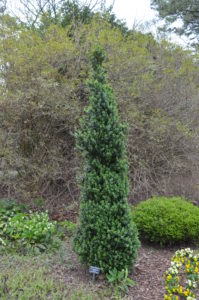Boxwoods and hollies are mainline evergreen shrubs, utilized for low hedging, privacy barriers. Single shrubs are planted solely for their architectural accent. Both hollies and boxwoods grow best in moist, well-drained soils and in full sun to partial shade. Both prefer soils with a pH of slightly acidic to slightly alkaline. Boxwoods tend to be more shade tolerant than Japanese hollies. In winter plant foliage may scorch or bronze if grown in open sun.
Plants are generally tolerant of pruning and shearing. Pruning too early in spring may promote tender new growth that is easily injured or killed by a late spring frost.
There are few shrubs that fit into narrow spaces better than ‘Dee Runk’ boxwood (Buxus sempervirens ‘Dee Runk’). Research has shown that Dee Runk is a better choice than currently popular cultivar ‘Graham Blandy’, which is seriously troubled by soil borne diseases, specifically Phytophthora root rot.
‘Sky Pencil’ Japanese holly (Ilex crenata ‘Sky Pencil’) exhibits a similar upright (fastigiate) form. They are finicky regarding soil drainage. Plants are particularly susceptible to soil root rot diseases including Phytophthora and Pythium.
Both ‘Dee Runk’ boxwood and ‘Sky Pencil’ holly grow well in large landscape containers on patios and along downtown streets in USDA zones 6-9. Expect mature shrub heights between 8-10 feet.


 Posted in
Posted in 
